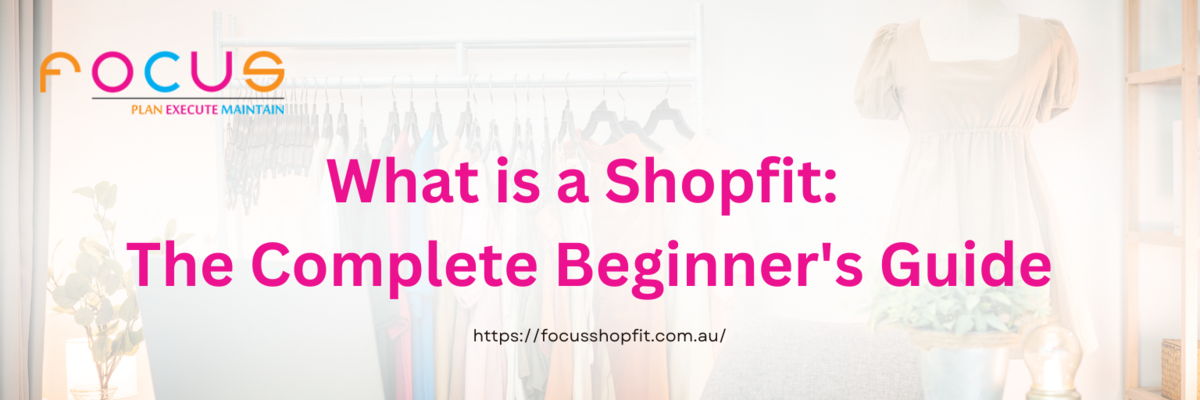What is a Shopfit? Shopfitting is an essential aspect of creating a successful retail space. It involves the design, construction, and installation of fixtures and fittings within a store to optimize its functionality and appeal. A well-executed shopfit in an Australian retail store or anywhere else in the world, can significantly enhance the customer experience and contribute to the overall success of a business. In this comprehensive beginner’s guide, we will explore the purpose of a shopfit, the benefits it offers, the process involved, and the various elements that make up a shopfit.

The Purpose of a Shopfit
The primary purpose of a shopfit is to create an environment that encourages customers to engage with the products or services offered by a business. It involves careful planning and execution to ensure that the layout, fixtures, and lighting work together harmoniously to attract customers and enhance their shopping experience. A well-designed shopfit can also help establish a brand identity, improve customer flow, and maximize the use of available space.
Benefits of a Well-Designed Shopfit
Investing in a well-designed shopfit can yield numerous benefits for a business. Firstly, it can significantly impact sales by creating an inviting and visually appealing environment that encourages customers to spend more time in the store and make purchases. A shopfit that showcases products effectively and provides a seamless shopping experience can increase customer satisfaction and loyalty. Additionally, a thoughtfully designed shopfit can enhance brand perception, positioning the business as professional, reliable, and trustworthy.

A well-executed shopfit can also improve operational efficiency. By optimizing the layout and placement of fixtures, it can facilitate smoother customer flow, reduce congestion, and minimize the time spent searching for items. This can lead to better productivity and employee satisfaction. Furthermore, a shopfit that incorporates energy-efficient lighting and sustainable materials can contribute to a business’s commitment to environmental responsibility.
What is a Shopfit: The Process
The shopfitting process typically involves several stages, starting from the initial concept design and ending with the final installation. The first step is to understand the business’s goals, target audience and desired aesthetic. This information is then used to develop a comprehensive design plan, including layout, fixtures, signage, and lighting.
Once the design is approved, the next phase involves sourcing materials, manufacturing fixtures, and coordinating with various contractors and suppliers. This stage requires careful project management to ensure that all elements are delivered on time and within budget. After all the components are ready, the installation process begins, which involves fitting the fixtures, connecting utilities, and adding finishing touches.
What is a Shopfit: Elements, Layout, Fixtures, and Lighting
Creating an effective shopfit involves careful consideration of three key elements: layout, fixtures, and lighting. The layout determines how the space is organized, including the placement of aisles, shelves, and checkout counters. It should be designed to optimize customer flow, ensure easy navigation, and highlight key areas or products. A well-planned layout can also create focal points and encourage customers to explore different sections of the store.
Fixtures play a crucial role in a shopfit, as they provide the infrastructure to display and merchandise products. They can include shelving units, display stands, racks, and cabinets, among others. Fixtures should be selected based on the type of products being sold and the desired aesthetic. They should be sturdy, functional, and easy to maintain, while also complementing the overall design theme.
Lighting is another vital element in shopfitting, as it sets the mood and illuminates the products. Different types of lighting, such as ambient, task, and accent lighting, can be used to create the desired atmosphere and highlight specific areas or products. Lighting should be carefully planned to ensure uniformity throughout the store, minimize shadows, and enhance visual clarity. It should also be energy-efficient and comply with relevant safety regulations.
Importance of Aesthetics in Shopfitting
Aesthetics play a crucial role in shopfitting, as they contribute to the overall ambiance and visual appeal of a store. The design and color scheme should align with the brand identity and target audience, creating a cohesive and memorable experience. A well-designed shopfit can evoke emotions, capture attention, and differentiate a business from its competitors.
The use of high-quality materials and finishes is essential in creating an aesthetically pleasing shopfit. From flooring and wall cladding to signage and decorative elements, every detail should be carefully chosen to enhance the overall design. Attention should be given to factors such as durability, ease of maintenance, and suitability for the intended purpose.
What is a Shopfit: Materials and Finishes
When it comes to shopfitting materials and finishes, there is a wide range of options available. The choice of materials should be based on factors such as durability, functionality, aesthetics, and budget. Common materials used in shopfitting include wood, metal, glass, laminates, and acrylics. Each material offers unique characteristics and can be tailored to suit specific design requirements.
Finishes, on the other hand, add the final touch to a shopfit, enhancing its visual appeal and durability. They can include options such as paint, varnish, veneer, powder coating, and vinyl wraps. The selection of finishes should align with the overall design concept and ensure longevity in a high-traffic retail environment.

Shopfitting Trends and Innovations
The field of shopfitting is continually evolving, with new trends and innovations emerging to meet the changing needs and expectations of customers. One of the prominent trends in recent years is the incorporation of technology into shopfitting. This can include interactive displays, touchscreens, virtual reality experiences, and smart lighting systems. Technology can enhance customer engagement, provide personalized experiences, and streamline operations.
Another trend is the focus on sustainable shopfitting. Businesses are becoming increasingly conscious of the environmental impact of their operations and are seeking eco-friendly solutions. This includes the use of recycled materials, energy-efficient lighting, and sustainable construction practices. Sustainable shopfitting not only reduces the carbon footprint but also resonates with environmentally conscious customers.
Hiring a Professional Shopfitting Company
While some businesses may attempt to undertake shopfitting in-house, it is generally recommended to hire a professional shopfitting company. A professional company brings expertise, experience, and industry knowledge to the table, ensuring that the shopfit is executed to the highest standards. They can provide end-to-end project management, from design and manufacturing to installation and post-completion services.
When selecting a shopfitting company, it is essential to consider its portfolio, reputation, and customer reviews. They should have experience in similar projects, an understanding of your business requirements, and a commitment to delivering on time and within budget. A professional shopfitting company can help bring your vision to life and create a retail space that reflects your brand identity.

The Impact of a Good Shopfit on Your Business
A well-executed shopfit can have a significant impact on a business’s success. It creates an inviting and visually appealing space that attracts customers, enhances their shopping experience, and increases sales. A good shopfit also improves operational efficiency, strengthens brand perception, and demonstrates a commitment to environmental responsibility.
From the layout and fixtures to the lighting and aesthetics, every element of a shopfit requires careful consideration and planning. By understanding the purpose of a shopfit, the benefits it offers, the process involved, and the various elements that make up a shopfit, businesses can make informed decisions and create a retail space that stands out from the competition.
If you’re looking to transform your retail space and optimize its potential, consider hiring a professional shopfitting company. They have the expertise and experience to bring your vision to life, creating a shopfit that aligns with your brand identity and resonates with your target audience. Invest in a good shopfit today and reap the rewards it brings to your business.
